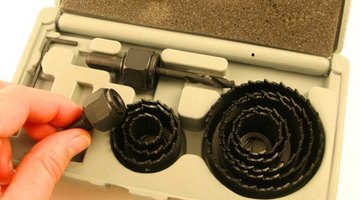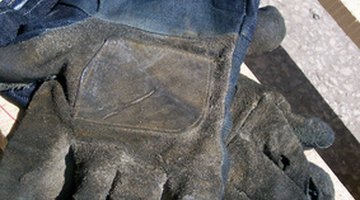Kitchen fitters work with new construction and they remodel existing kitchens. According to the website Careers Advice, kitchen fitting involves tearing out old kitchen units; identifying and moving sources of water, gas and electricity; making repairs before installation; installing and levelling cupboards, counter tops and appliances; and cleaning up after installation. Kitchen-fitting tools are common to other types of construction and repair tools, and if well maintained, will last for many years.
Manual Tools
To remove kitchen cabinets, you will probably need a crowbar and claw hammer to pry the cabinets away from the walls or lift the counter top from the cabinets. A flat-bladed scraper is useful for removing old glue and silicone sealer from walls.
When fitting new kitchen cabinets, you might need a rubber mallet for gently banging the cupboards into place. You will need a flat-bladed scraper and filler to smooth over small holes and dings in the sheetrock. A hammer, selection of nails and a selection of screwdrivers will also be useful if you're installing shelving.
A spirit level, shims and glue are necessary to help you level cabinets and counter tops, and you might need a handsaw for trimming excess materials in tight locations.
- To remove kitchen cabinets, you will probably need a crowbar and claw hammer to pry the cabinets away from the walls or lift the counter top from the cabinets.
- A spirit level, shims and glue are necessary to help you level cabinets and counter tops, and you might need a handsaw for trimming excess materials in tight locations.
Power Tools

You will need a drill and a set of drill bits for loosening screws from existing cabinets and driving screws into place for new cabinets. If you must run water lines or electrical cable through cabinets, you'll need a hole saw attachment for your drill to cut holes in the cabinet walls. You may also need a powered screwdriver for spots that are too tight for your drill.
A jigsaw with both metal and wood blades can trim cabinets and countertop materials on site. If you're installing a granite or marble counter top, you may need a grinder to shape and smooth the edges, or for adjusting the fit.
- You will need a drill and a set of drill bits for loosening screws from existing cabinets and driving screws into place for new cabinets.
- If you're installing a granite or marble counter top, you may need a grinder to shape and smooth the edges, or for adjusting the fit.
Electrical, Plumbing and Gas Tools
Bob Villa recommends using an outlet tester, circuit tester or continuity tester to ensure you have shut off the power to any electrical socket you intend to work on. To move or install electrical sockets or cables, you will need hand-held wire cutters and stripper, screwdrivers, pliers and electrical tape. For plumbing jobs, you'll need a pipe cutter, pipe wrench, plumber's putty, silicone tape and silicone sealer. To work with gas, you'll need adjustable wrenches and pipe thread compound to seal any joints.
- Bob Villa recommends using an outlet tester, circuit tester or continuity tester to ensure you have shut off the power to any electrical socket you intend to work on.
- To work with gas, you'll need adjustable wrenches and pipe thread compound to seal any joints.
Other Tools

If you're removing or installing wall cabinets or shelves, you'll need steps or a ladder. Use a sack barrow, dolly or hand truck to move appliances. For wall oven installation, use a small scissor jack to lift the appliance to the correct height before sliding it into place. You may have to build a small scaffold to help you raise heavier ventilation hoods to the ceiling or furdown above the hob.
For project cleanup, you will need a broom to sweep the floor and cloths to wipe down the cabinets, counter tops and appliance exteriors. You may also need a mop and bucket to clean dirt or stains from the floor. Don't forget to wear safety equipment such as gloves, face masks and goggles as needed.
- If you're removing or installing wall cabinets or shelves, you'll need steps or a ladder.
- For project cleanup, you will need a broom to sweep the floor and cloths to wipe down the cabinets, counter tops and appliance exteriors.
